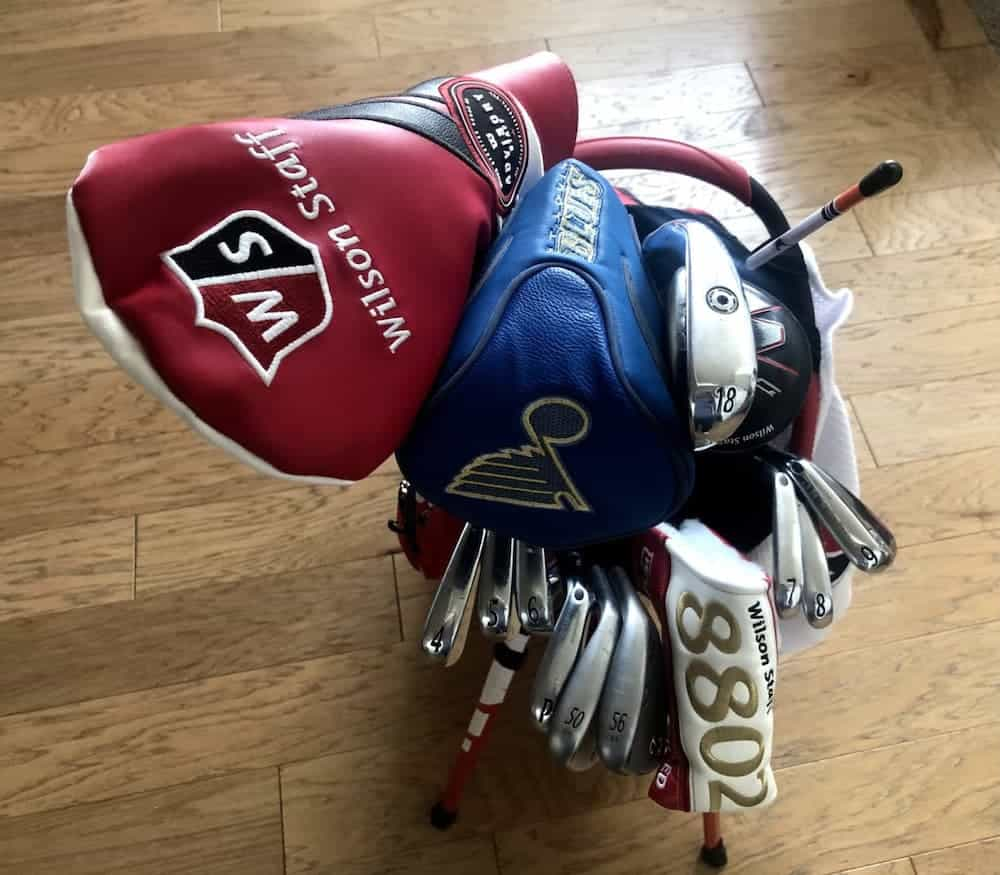How Many Golf Clubs Can You Carry?
We are allowed a maximum of 14 golf clubs in our bags when playing. Unless you play in a tournament or a match with someone that may care that you have an extra club in the golf bag, it may not matter but sometimes you may forget that you have too many and forget to take one out when it would matter.
Extra clubs can give you an advantage over someone else and give you extra options when playing the course. You can carry less than 14 and most beginners should not carry the maximum until they start having consistent contact and distances among their current clubs. You will know when you need to add clubs when you feel you have a big gap in distance in between clubs.
Which Golf Clubs Can I Choose?
It does not matter which 14 clubs you carry. You can carry two putters (which I’ve done before) or two drivers (Phil Mickelson has done this) so you can carry whichever clubs best fit your overall golf game. Since we are only allowed to carry no more than 14 clubs in our golf bag, we want to make sure we carry 14 clubs that we will use and know how to use properly.
I’ve seen many golfers carry clubs that they never use and even seen two wedges with the same degrees of loft. I understand that not every golfer has the luxury of buying golf clubs at will but I want to address the topic of an ideal set-up and to understand your clubs compared to the others.
Strategically Select Your Golf Clubs
Understanding why the ball goes farther or higher for each club will make you realize that the clubs are just labeled as a number and name. Pay attention to the yardages and trajectory of your clubs. You want to spread out your yardages so you have a club to hit for different yardages. You can also look at the trajectory on how you want your ball to approach the greens and fairways.
Most amateur golfers have a “favorite club” that they hit well and with confidence. If you don’t feel confident or hit other hybrids poorly, learn how to use that confident club in ways to get different yardages. Don’t carry clubs that you don’t use.
Knowing your yardage for each club and having a game plan with them are two of the most important elements in golf course management.
Know your Clubface Lofts
All clubs must have a name to identify them but down to it, the lofts of the clubs is what you should be familiar with. You don’t need to know every club’s loft but do need to know how they are spaced out among each other. Let’s start off with the irons as every club has a different length and lofts.
The difference in loft for each iron should be four degrees consecutively except in the longer irons which may be 3 degrees. Every clubmaker may be a degree or two off but you should know where your irons begin and end.
What Happens If I Carry Too Many Clubs?
The penalty for carrying too many golf clubs in your bag is 2 strokes per hole for stroke play (up to 4 penalty strokes) and a loss of 1 hole during Match Play.
Hardly ever does a rules official or anyone else directly count and check how many clubs you carry during an official event so most of the time this rule is broken because you don’t even realize that you have more than 14 clubs in your bag.
If you are playing in a stroke play event which means you are playing in a field of players, you would be penalized two strokes per hole you carry too many. This seems absurd if you carry too many the entire round and realize it at the end so the rules say that you will be assessed a maximum of four strokes for this violation. You would add two strokes to the first hole(s) you played with too many clubs.
In match play, which means you are playing someone one-on-one or in Fourball which is two-on-two, you would lose up to 2 holes that you played with too many clubs.
If you are mid-match or mid-round, you would inform your playing competitors or opponent of the violation and would have to declare what clubs are not to be used going forward by turning the club upside down in your bag. Then update the scorecard or match with them so you all update the round from there.
The 14 Golf Clubs in My Bag
Here is my breakdown of clubs in my bag. I want to make sure I have a setup that can cover any yardage I may have to hit including the trajectory of how I want the ball to fly.
| 1. | Driver |
| 2. | Fairway Wood |
| 3. | Driving Iron |
| 4. | 4 Hybrid |
| 5. | 4 Iron |
| 6. | 5 Iron |
| 7. | 6 Iron |
| 8. | 7 Iron |
| 9. | 8 Iron |
| 10. | 9 Iron |
| 11. | Pitching Wedge |
| 12. | Gap Wedge |
| 13. | Sand Wedge |
| 14. | Putter |
Let me provide a more detailed description of the purpose each of these clubs have in my golf bag arsenal.
Driver
9.5 degree head but adjusted in the hosel to create 10.25 degrees. I play at 5,400 ft elevation so I want the ball to carry more to gain more yardage in the thin air.
- Average 290 yards off the tee
- Clubface angle: 10.25 degrees
Fairway Wood
I hit the ball low so I wanted more height so I could come into a green with more spin and softer.
- Average 265 yards off the tee
- Clubface angle: 16.5 degrees
Driving Iron
I call this my Stinger because the ball comes off the face hot, hard and low.
- Average 250 yards off the tee
- Clubface angle: 18 degrees
4 Hybrid
This club helps me get out of the rough but produces good height to approach greens.
- Average 235 yards
- Clubface angle: 22 degrees
4 Iron
- Average 215 yards
- Clubface angle: 23 degrees
5 Iron
- Average 205 yards
- Clubface angle: 26 degrees
6 Iron
- Average 195 yards
- Clubface angle: 30 degrees
7 Iron
- Average 185 yards
- Clubface angle: 34 degrees
8 Iron
- Average 175 yards
- Clubface angle: 38 degrees
9 Iron
- Average 165 yards
- Clubface angle: 42 degrees
Pitching Wedge
- Average 155 yards
- Clubface angle: 46 degrees
Gap Wedge
- Average 140 yards (Use 115-145 yards)
- Clubface angle: 50 degrees
Sand Wedge
- Average 110 yards (Use 110 yards and less)
- Clubface angle: 56 degrees
Learn how to choose your wedges to ensure you’ve got the right equipment for every scenario near the green.
Putter
- I use the Odyssey Triple Track Ten S (OTTTS) 34” long putter which is a mallet type. The head is a bit toe hand which means I want to put a slight arc in my putting stroke. The look of it has a wide white aiming line with red and blue stripes to help me align better and to see my stroke path better. This helps me putt with more confidence.
- I also like the softer face instead of a milled face which helps me be confident on my distance. The S in the name of the putter is for Slant as the hosel had a slight bend forward which helps me set up over the ball better and visually makes me feel like my hands will always be ahead of the putter head through impact. Lately I have been forward pressing my hands during putting to improve my consistency.


